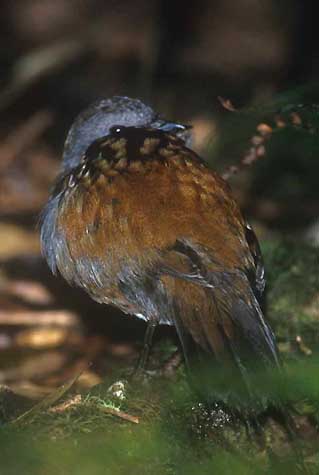Blakers, M., S. J. J. F. Davies, and P. N. Reilly. 1984. The
Atlas of Australian Birds. Royal Australian Ornith. Union, Melbourne Univ.
Press, Carlton, Victoria.
Coates, B. J. 1990. The Birds of Papua New Guinea. Part II. Dove Publ.,
Ltd., Alderley, Australia.
Schodde, R., and I.J. Mason. 1999. The Directory of Australian Birds,
Passerines. CSIRO Publishing.
Sibley, C. G. 1996. Birds of the World, on diskette, Windows version
2.0. Charles G. Sibley, Santa Rosa, CA.
Sibley, C. G., and J. E. Ahlquist. 1990. Phylogeny and Classification
of Birds: A Study in Molecular Evolution. Yale Univ. Press, New Haven,
CT.
Simpson, K, and N. Day. 1996. A Field Guide to the Birds of Australia,
revised 5th ed. Penguin Books Australia Ltd., Ringwood, Victoria, Australia.
 The Logrunners are a small Australasian family composed of just two species
in the genus Orthonyx: the Chowchilla (left) and the Logrunner
(below).
These close-up pictures are both by California photographer
Ed Harper
during one of his visits "down under." Both species live on the ground
in wet humid forests of eastern Australia and, in the case of Logrunner,
locally in montane New Guinea. Although they sometimes forage in thickets
or undergrowth for berries, they primarily scratch or dig in the
leaf litter for small prey items like insects and earthworms. During these
efforts they brace themselves with their stiffened tails that end in sharp
spines (vaguely like the tails of woodpeckers who use their tails for an
entirely different sort of bracing). They scratch with both feet and toss
leaves aside with their bills; these movements create characteristic small
circular cleared areas on the forest floor.
The Logrunners are a small Australasian family composed of just two species
in the genus Orthonyx: the Chowchilla (left) and the Logrunner
(below).
These close-up pictures are both by California photographer
Ed Harper
during one of his visits "down under." Both species live on the ground
in wet humid forests of eastern Australia and, in the case of Logrunner,
locally in montane New Guinea. Although they sometimes forage in thickets
or undergrowth for berries, they primarily scratch or dig in the
leaf litter for small prey items like insects and earthworms. During these
efforts they brace themselves with their stiffened tails that end in sharp
spines (vaguely like the tails of woodpeckers who use their tails for an
entirely different sort of bracing). They scratch with both feet and toss
leaves aside with their bills; these movements create characteristic small
circular cleared areas on the forest floor. The
Chowchilla
(above) is dark brown above and white below (male) or with a reddish throat
and white belly (female). Both sexes have prominent eye-rings. They inhabit
the northern highlands of eastern Australia. The
Logrunner (right)
has a more complex pattern of grays and tans with a black side-stripe but,
like the Chowchilla, it is sexually dimorphic. Males have white throats
while females have rusty throats. Both birds shown on this page appear
to be males. The Logrunner lives in more southerly mountains and east coastal
forests.
The
Chowchilla
(above) is dark brown above and white below (male) or with a reddish throat
and white belly (female). Both sexes have prominent eye-rings. They inhabit
the northern highlands of eastern Australia. The
Logrunner (right)
has a more complex pattern of grays and tans with a black side-stripe but,
like the Chowchilla, it is sexually dimorphic. Males have white throats
while females have rusty throats. Both birds shown on this page appear
to be males. The Logrunner lives in more southerly mountains and east coastal
forests.